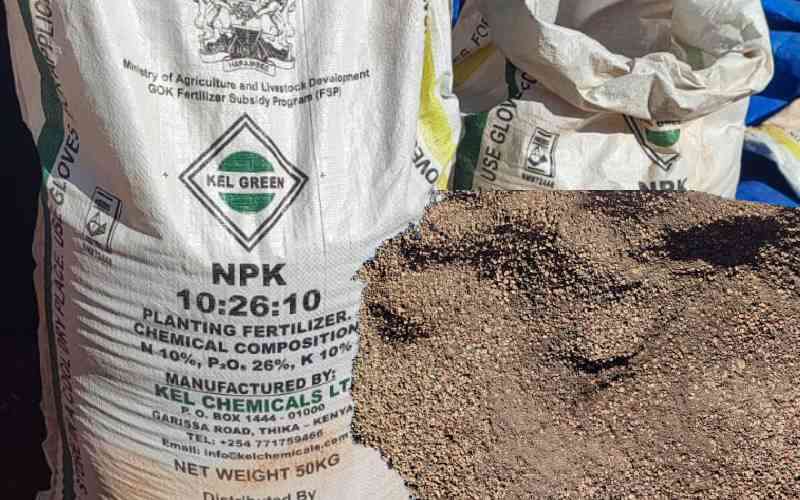As famine ravages some regions in the country, other areas have bumper harvests.
Tucked away in the highlands of Kiambu County, Limuru is a town where farmers are harvesting big despite the harsh climatic conditions.
Farmers there, compared to counties such as Kilifi, Kwale, Tana River, Taita Taveta, Garissa and Wajir where residents are facing starvation, are making harvests enough to cater for both their domestic and commercial needs.
Alfred Karanja, who is a subsistence farmer, has planted an array of crops such as kales, cabbages, maize and beans on his land. He says that he harvests enough produce to feed his family as well as take to the market on Wednesdays and Saturdays.
“When the climate is favourable, there is produce in excess but this causes the prices to go down,” said Mr Karanja.
Irrigation measures
The farmer said he is able to produce at least seven 90kg bags of maize with each retailing at Sh2,700 and kales retailing at Sh3,000 per bag, noting that most of his produce is sold to markets in Nairobi.
Jane Wambui also owns a ‘sukuma wiki’ farm in the area and admits that it is one of her major sources of income.
She says that in a good season, she is able to harvest at least 21 bags of ‘sukuma wiki’ in her three-quarter-acre piece of land.
“As long as there is a constant supply of water, we are confident that the harvest will be bountiful. We are also feeling the climatic effects but they are not as severe as in the other counties,” she said.
The farmers, however, say they have been forced to adopt alternative irrigation measures such as piping water from the nearest streams instead of using tap water, which is very expensive.
Karanja says since the rains stopped, he opted to plant beans and coriander, which he irrigates with water used for other chores such as laundry and washing dishes.
“Kenyans should learn how to preserve water in this time of scarcity. Water used to clean utensils and do laundry is not harmful to crops as long as one doesn’t use detergents,” Karanja said.
Joseph Ndungu, also a farmer, blamed climate change for decline in farming and rise of the real estate sector in the region.
Most residents of Kisii region are also enjoying plenty of harvest despite the diminishing land sizes.
Stay informed. Subscribe to our newsletter
The region enjoys high supply of food throughout the year.
Most farmers in the area sell fresh vegetables in bulk and have constant supply for the Kisii population and the surrounding regions.
A vegetable vendor at the Kisii Central Business District market, Grace Kemunto said the region was well endowed with all manner of foodstuff.
“Most farmers have embarked on greenhouse farming. Most agricultural produce we receive in the market is from greenhouses,” said Kemunto.
Most smallholders are dropping maize production, which has positively impacted on banana farming.
Bananas have now become a staple food in the Kisii community.
Most farmers have embraced tissue culture farming, leading to large production of bananas.
Vegetable vendors, in trucks and pick-ups, always flock to Daraja Mbili open-air market in Kisii town every Monday and Thursday.
Kisii Agriculture and Livestock Executive Vincent Sagwe said that with modern farming technology, the region can produce surplus food.
“The region is blessed with rich soils and good climate. Every farmer, whether rich or poor, practises farming hence the stable supply of food,” said Mr Sagwe.
In Nyamira County, there is enough for the population, according to Governor John Nyagarama.
Improvement of crop production, which is centred on diversification, has yielded more results, which have translated to food security.
Farmers who have been growing indigenous species of crops now have switched to genetically improved food crops like bananas and maize.
Farmers across the county now have access to tissue culture banana seedlings, which have increased prospects for food security in the devolved unit in the next two years.
Fruits have been dominating local markets, something that has affected pricing of the products, with many farmers selling their produces at throwaway prices.
Avocados, pineapples, passion fruits and pumpkins are just but a few of the green produce flooding local markets.
Options for alternative diets have also been made easier since production of maize has been facing serious challenges associated with climate change.
Four years ago, lethal maize necrosis disease was declared a disaster after ravaging food crops in Nyanza and South Rift parts of the country.
A 90kg of maize currently trades at around Sh3,000, making it affordable to most people since they can sell alternative crops to buy the grain for consumption.
-Reporting by Josphat Thiong'o, Eric Abuga and Stanley Ongwae
 The Standard Group Plc is a
multi-media organization with investments in media platforms spanning newspaper
print operations, television, radio broadcasting, digital and online services. The
Standard Group is recognized as a leading multi-media house in Kenya with a key
influence in matters of national and international interest.
The Standard Group Plc is a
multi-media organization with investments in media platforms spanning newspaper
print operations, television, radio broadcasting, digital and online services. The
Standard Group is recognized as a leading multi-media house in Kenya with a key
influence in matters of national and international interest.
 The Standard Group Plc is a
multi-media organization with investments in media platforms spanning newspaper
print operations, television, radio broadcasting, digital and online services. The
Standard Group is recognized as a leading multi-media house in Kenya with a key
influence in matters of national and international interest.
The Standard Group Plc is a
multi-media organization with investments in media platforms spanning newspaper
print operations, television, radio broadcasting, digital and online services. The
Standard Group is recognized as a leading multi-media house in Kenya with a key
influence in matters of national and international interest.








